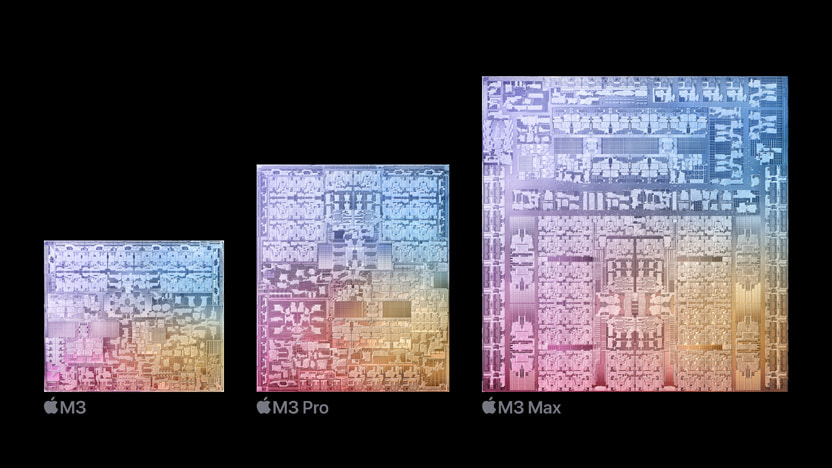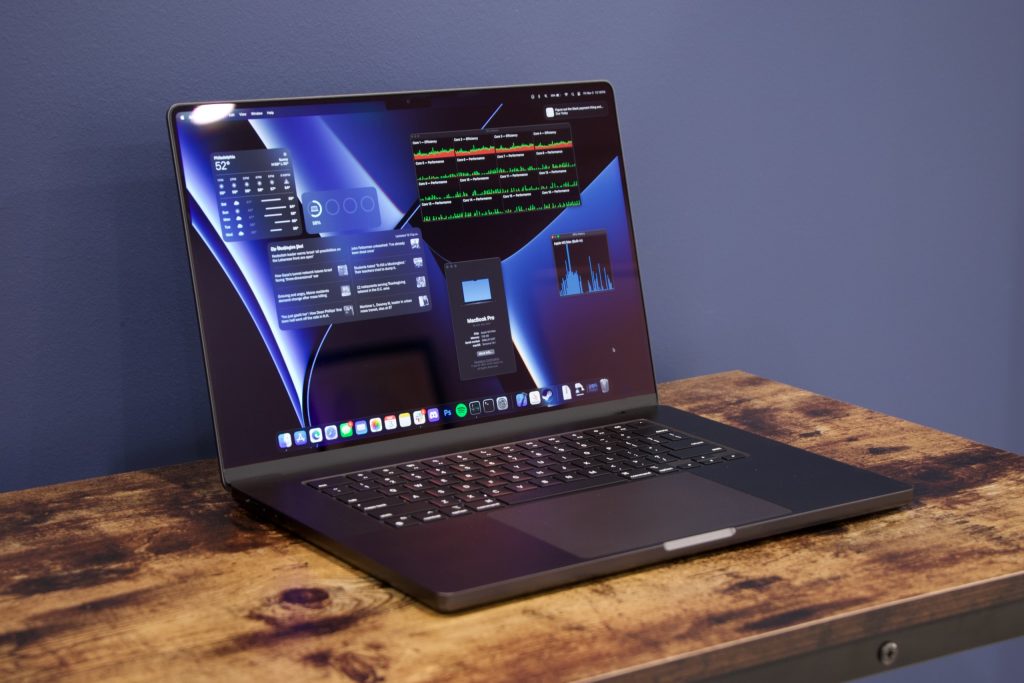industry’s first 3-nanometer chip for personal computers enables next-generation GPU architecture, enabling dramatic performance improvements, faster CPUs and Neural Engines, and support for larger unified memory capacities
For the first time, Apple is announcing three chips at once. The M3, M3 Pro, and M3 Max are the most advanced chips ever created for personal computers.
The M3 chip family features next-generation GPUs, the biggest leap forward in graphics architecture for Apple silicon to date. This GPU is faster, and more efficient, and introduces a new technology called Dynamic Caching, as well as new rendering features like hardware-accelerated ray tracing and mesh shading on Mac for the first time. Rendering speeds will be up to 2.5x faster than the M1 chip family. The CPU’s high-performance and high-efficiency cores are 30 percent and 50 percent faster than those in the M1, respectively, and the Neural Engine is 60 percent faster than the Neural Engine in the M1 chip family. The new media engine also supports AV1 decoding, providing a more efficient and high-quality video experience for streaming services. The M3 chip family continues the rapid innovation of Apple silicon, bringing significant enhancements and new features to the new MacBook Pro and iMac.
The M3 chip family is built using industry-leading 3-nanometer process technology and continues Apple’s rapid innovation.
The all-new GPU features Dynamic Caching, mesh shading, and hardware-accelerated ray tracing.
The next-generation GPU featured in the M3 chip family is the biggest leap forward in Apple’s graphics architecture. Unlike traditional GPUs, it features Dynamic Caching, which allocates the hardware’s local memory usage in real time. Dynamic Caching ensures that only the exact amount of memory needed for each task is used. This is an industry first, provides clarity for developers, and is the basis for new GPU architectures. This dramatically increases average GPU utilization, resulting in a significant performance boost for the most demanding professional apps and games.
The next-generation GPUs featured in the M3 chip family represent the biggest leap forward in graphics architecture for Apple silicon to date, featuring Dynamic Caching, mesh shading, and hardware-accelerated ray tracing.

Faster, more efficient CPU
The M3, M3 Pro, and M3 Max next-generation CPUs feature improved high-performance and high-efficiency core architectures. The high-performance cores are up to 30 percent faster than those in the M1 family, so you can perform tasks like compiling and testing millions of lines of code even faster in Xcode, and musicians can create hundreds of audio tracks, plug-ins, and more in Logic Pro. You can use virtual sound sources. The high-efficiency cores are up to 50 percent faster than M1’s high-efficiency cores, making everyday tasks faster than ever while ensuring your system maximizes battery life. These cores deliver the same multi-threaded performance as M1 at just half the power, and up to 35 percent more performance at peak power.
Unrivaled unified memory architecture with up to 128GB
Each chip in the M3 family features the unified memory architecture synonymous with Apple silicon. This provides high bandwidth, low latency, and unparalleled power efficiency. By having memory in one pool within a dedicated package, all technologies within a chip can access the same data without having to copy data across multiple memory pools, further improving performance and efficiency. It reduces the amount of memory the system requires for most tasks. Additionally, support for up to 128GB of memory enables workflows not previously possible on notebooks, such as AI developers working with even larger Transformer models with billions of parameters. .
custom engine for AI and video
M3, M3 Pro, and M3 Max also feature an enhanced Neural Engine that accelerates powerful machine learning (ML) models. The Neural Engine is up to 60 percent faster than those in the M1 chip family, further accelerating AI/ML workflows while keeping data on-device for privacy. Topaz’s powerful AI image processing tools, like noise reduction and ultra-high resolution, are now even faster. Performance improvements have also been made to scene edit detection in Adobe Premiere and smart fit in Final Cut Pro.
All three chips in the M3 family also feature advanced media engines, providing hardware acceleration for the most popular video codecs, including H.264, HEVC, ProRes, and ProRes RAW. Additionally, for the first time, the media engine now supports AV1 decoding, enabling power-efficient playback for streaming services and extending battery life.
M3: Delivers incredible performance for the most popular systems
M3 has 25 billion transistors, 5 billion more than M2. Equipped with a 10-core GPU and next-generation architecture, graphics performance is 65 percent faster than M1. Games like Myst have incredibly realistic lighting, shadows, and reflections. M3 is equipped with an 8-core CPU consisting of 4 high-performance cores and 4 high-efficiency cores, and the CPU performance is up to 35 percent faster than M1. It also supports up to 24GB of unified memory.

M3 Pro: For users who need even more performance
M3 Pro is built with 37 billion transistors and an 18-core GPU for extremely fast performance when handling more graphics-intensive tasks. The GPU is up to 40 percent faster than the M1 Pro. Supported unified memory capacity increases to up to 36GB, allowing users to tackle even larger projects on MacBook Pro while on the go. The 12-core CPU design features 6 high-performance cores and 6 high-efficiency cores, delivering a single-threaded performance that is up to 30 percent faster than M1 Pro. Actions like composing and manipulating giant panoramic photos in Adobe Photoshop are faster than ever on the new MacBook Pro with M3 Pro.

M3 Max: Takes on the most demanding professional workloads with an incredible leap in performance
M3 Max increases the transistor count to 92 billion, taking professional performance to the next level. The 40-core GPU is up to 50 percent faster than M1 Max and supports up to 128GB of unified memory, allowing AI developers to work with even larger Transformer models with billions of parameters. The 16-core CPU features 12 high-performance cores and 4 high-efficiency cores, delivering amazing performance that is up to 80 percent faster than M1 Max. Featuring two ProRes engines, M3 Max also makes video post-production work faster and smoother, even when processing the highest resolution content, including DaVinci Resolve, Adobe Premiere Pro, and Final Cut. You can do this with either Pro. M3 Max has industry-leading battery life for professional notebooks Designed for professionals who require the highest performance possible with a MacBook Pro.
Pricing and Availability
- Customers can order the new MacBook Pro starting today, Monday, October 30, on apple.com/store and in the Apple Store app in 27 countries and regions, including the U.S. It will begin arriving to customers, and will be in Apple Store locations and Apple Authorized Resellers, starting Tuesday, November 7.
- The 14-inch MacBook Pro with M3 starts at $1,599 (U.S.) and $1,499 (U.S.) for education; the 14‑inch MacBook Pro with M3 Pro starts at $1,999 (U.S.) and $1,849 (U.S.) for education; and the 16‑inch MacBook Pro starts at $2,499 (U.S.) and $2,299 (U.S.) for education.
- Additional technical specifications, configure-to-order options, and accessories are available at apple.com/mac.
- With Apple Trade In, customers can trade in their current computer and get credit toward a new Mac. Customers can visit apple.com/shop/trade-in to see what their device is worth.
- Every customer who buys a Mac from Apple can enjoy a free Online Personal Session with an Apple Specialist, get their product set up in select stores — including help with data transfer — and receive guidance on how to make their new Mac work the way they want.
Also Read | Apple set to Reveal Major AI features and Upgrades to Siri at WWDC 2024: All the details
The power-efficient performance of the M3, M3 Pro, and M3 Max meets Apple’s high standards for energy efficiency for the new MacBook Pro and iMac, delivering the longest battery life in Mac history at up to 22 hours on the new MacBook Pro. Masu 2. As a result, your Mac needs to be plugged in for less time and consumes less energy over its lifecycle.
Today, Apple is a carbon-neutral global company committed to achieving net-zero climate impact across all operations, including the entire manufacturing supply chain and the lifecycle of all products, by 2030. This means making every chip in every Mac carbon neutral, from design to production.
❤️ If you liked the article, like and subscribe to my channel, “Securnerd”.
👍 If you have any questions or if I would like to discuss the described hacking tools in more detail, then write in the comments. Your opinion is very important to me!